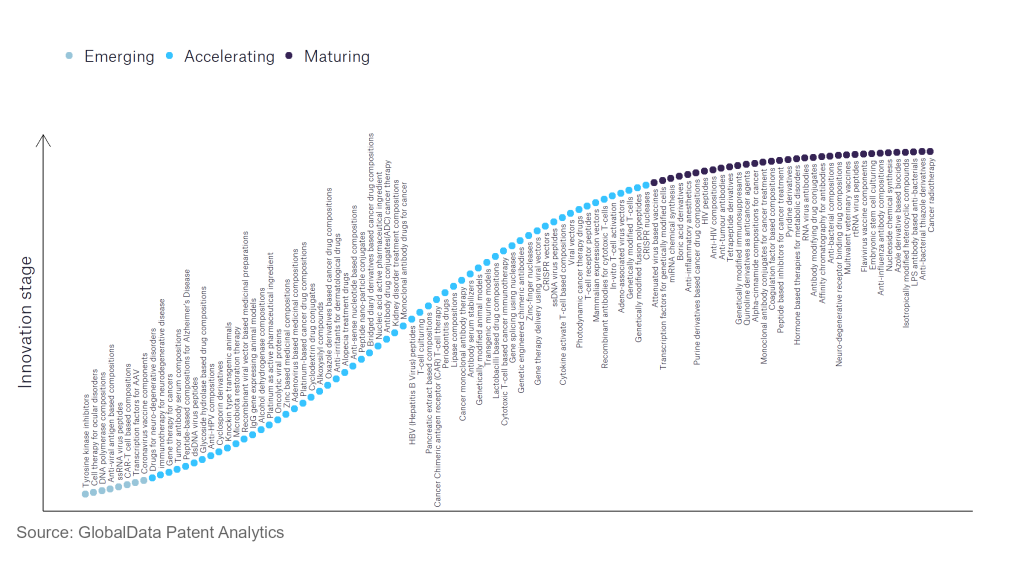The pharmaceutical industry continues to be a hotbed of innovation, with activity driven by the evolution of new treatment paradigms, and the gravity of unmet needs, as well as the growing importance of technologies such as pharmacogenomics, digital therapeutics, and artificial intelligence. In the last three years alone, there have been over 633,000 patents filed and granted in the pharmaceutical industry, according to GlobalData’s report on Innovation in Pharmaceuticals: Peptide nano-particle conjugates. Buy the report here.
However, not all innovations are equal and nor do they follow a constant upward trend. Instead, their evolution takes the form of an S-shaped curve that reflects their typical lifecycle from early emergence to accelerating adoption, before finally stabilising and reaching maturity.
Identifying where a particular innovation is on this journey, especially those that are in the emerging and accelerating stages, is essential for understanding their current level of adoption and the likely future trajectory and impact they will have.
110 innovations will shape the pharmaceutical industry
According to GlobalData’s Technology Foresights, which plots the S-curve for the pharmaceutical industry using innovation intensity models built on over 756,000 patents, there are 110 innovation areas that will shape the future of the industry.
Within the emerging innovation stage, cell therapy for ocular disorders, coronavirus vaccine components, and DNA polymerase compositions are disruptive technologies that are in the early stages of application and should be tracked closely. Adeno-associated virus vectors, alcohol dehydrogenase compositions, and antibody serum stabilisers are some of the accelerating innovation areas, where adoption has been steadily increasing. Among maturing innovation areas are anti-influenza antibody compositions and anti-interleukin-1, which are now well established in the industry.
Innovation S-curve for the pharmaceutical industry

Peptide nano-particle conjugates is a key innovation area in the pharmaceutical industry
By tagging peptides with nanoparticles, peptide nano-particle conjugates allow enhanced control over their biological behaviour, overcoming intrinsic limitations of the individual materials. The conjugation of antimicrobial peptides (AMPs) with nanoparticles increases the local concentration of the peptide at the site of delivery, improving peptide targeting. Silver nanoparticles (AgNPs) and AMP conjugates exhibit increased stability with higher activity than AMPs or AgNPs separately.
GlobalData’s analysis also uncovers the companies at the forefront of each innovation area and assesses the potential reach and impact of their patenting activity across different applications and geographies. According to GlobalData, there are 260+ companies, spanning technology vendors, established pharmaceutical companies, and up-and-coming start-ups engaged in the development and application of peptide nano-particle conjugates.
Key players in peptide nano-particle conjugates – a disruptive innovation in the pharmaceutical industry
‘Application diversity’ measures the number of different applications identified for each relevant patent and broadly splits companies into either ‘niche’ or ‘diversified’ innovators.
‘Geographic reach’ refers to the number of different countries each relevant patent is registered in and reflects the breadth of geographic application intended, ranging from ‘global’ to ‘local’.
Patent volumes related to peptide nano-particle conjugates
Source: GlobalData Patent Analytics
F. Hoffmann-La Roche is the leading patent filer in the peptide nano-particle conjugates space. The company develops drugs and diagnostics to treat major diseases. It provides medicines for the treatment of cancer, auto-immune diseases, central nervous system disorders, ophthalmological disorders, infectious diseases, and respiratory diseases. Takeda Pharmaceutical and Selecta Biosciences are the other key patent filers of peptide nano-particle conjugates.
In terms of application diversity, Onxeo is the top company, followed by Cerion and StemBios Technologies. By means of geographic reach, the German Cancer Research Center holds the top position. Halozyme Therapeutics and Soligenix stand in second and third positions, respectively.
To further understand the key themes and technologies disrupting the pharmaceutical industry, access GlobalData’s latest thematic research report on Pharmaceutical.
Data Insights
From

The gold standard of business intelligence.
Blending expert knowledge with cutting-edge technology, GlobalData’s unrivalled proprietary data will enable you to decode what’s happening in your market. You can make better informed decisions and gain a future-proof advantage over your competitors.



